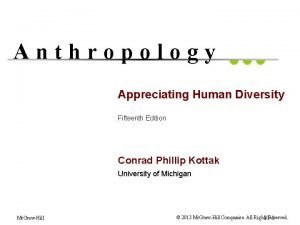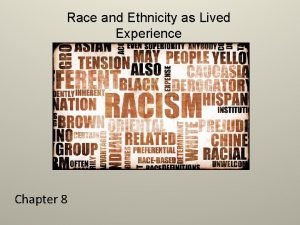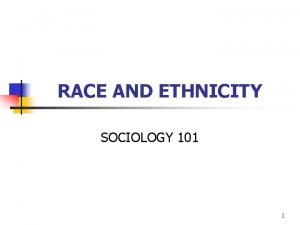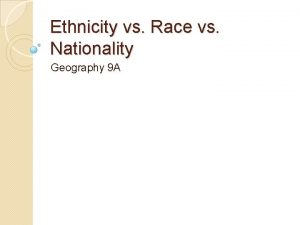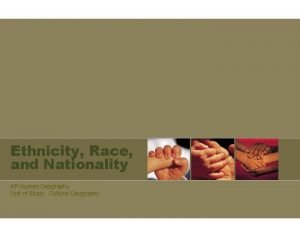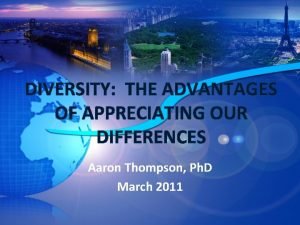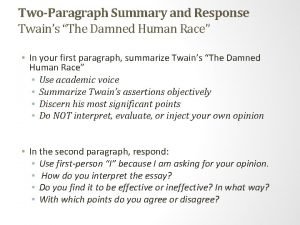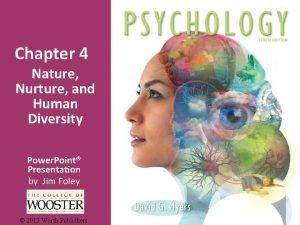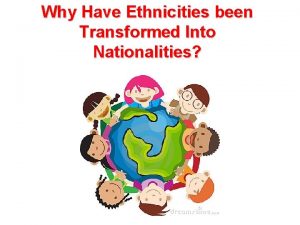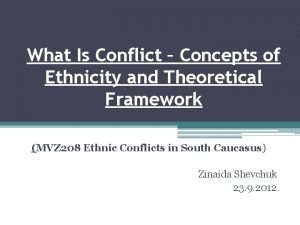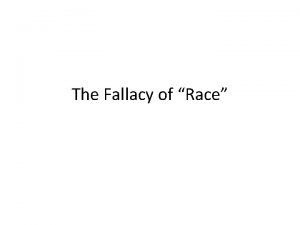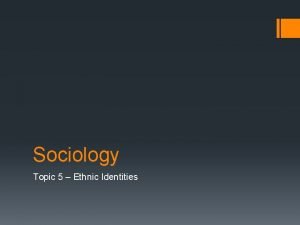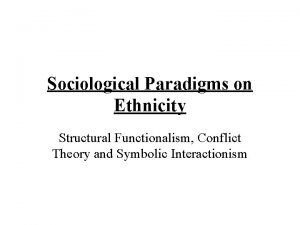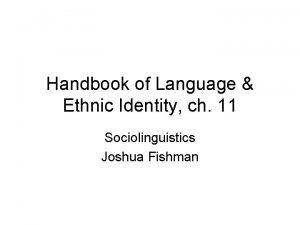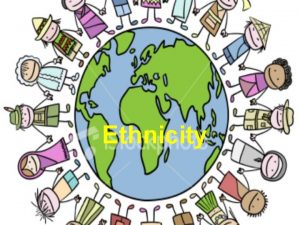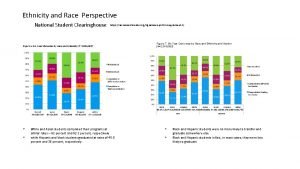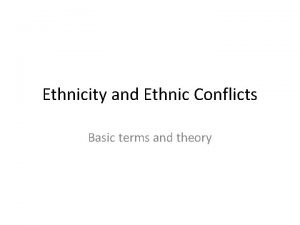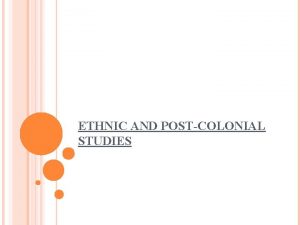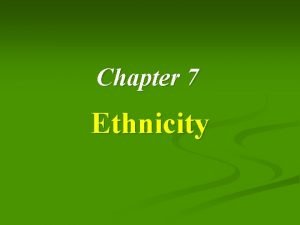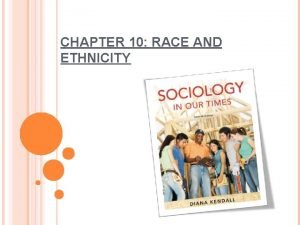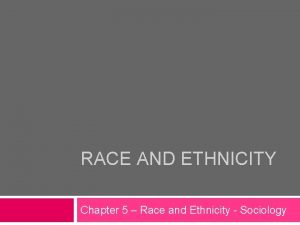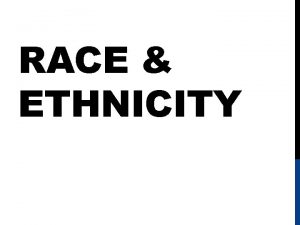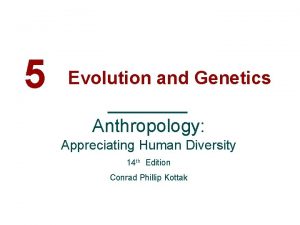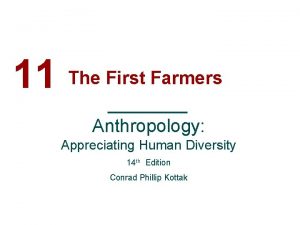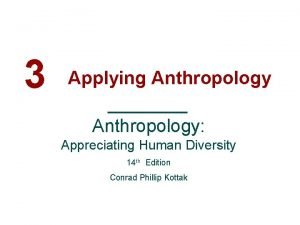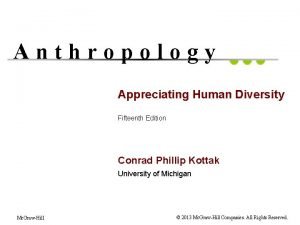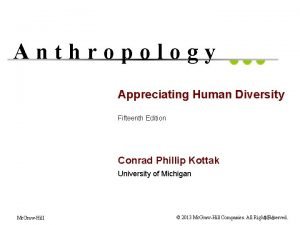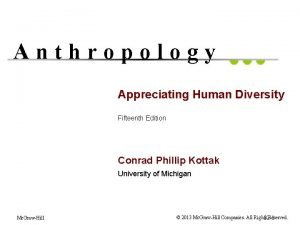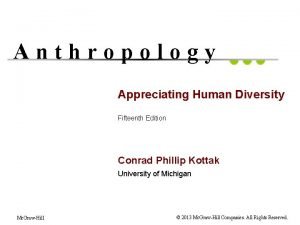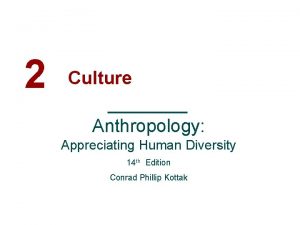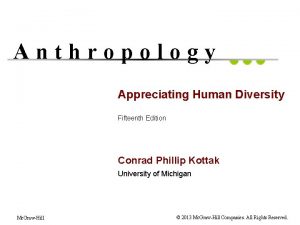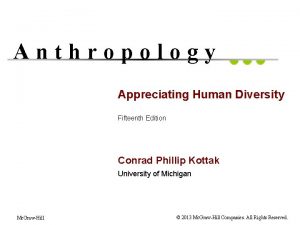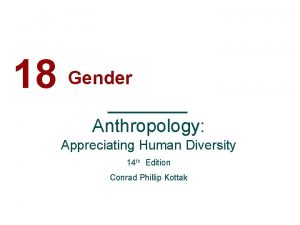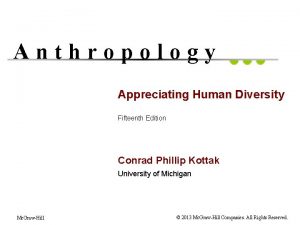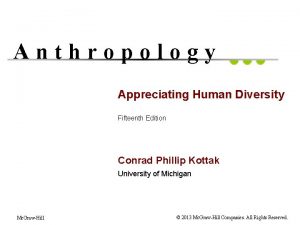15 Ethnicity and Race Anthropology Appreciating Human Diversity

































- Slides: 33

15 Ethnicity and Race Anthropology: Appreciating Human Diversity 14 th Edition Conrad Phillip Kottak

2 Ethnicity and Race • • • Ethnic Groups and Ethnicity Race and Ethnicity The Social Construction of Race Ethnic Groups, Nations, and Nationalities Ethnic Tolerance and Accommodation Roots of Ethnic Conflict © 2011 The Mc. Graw-Hill Companies, Inc.

3 Ethnicity and Race • What is social status, and how does it relate to ethnicity? • How are race and ethnicity socially constructed in various societies? • What are the positive and negative aspects of ethnicity? © 2011 The Mc. Graw-Hill Companies, Inc.

4 Ethnic Groups and Ethnicity • Ethnic group: a gathering whose members share certain beliefs, values, habits, customs, and norms because of their common background • Ethnicity: identification with, and feeling part of, a particular ethnic group and exclusion from certain other groups because of this affiliation © 2011 The Mc. Graw-Hill Companies, Inc.

5 Ethnic Groups and Ethnicity • Ethnic feelings and their associated behavior vary in intensity within ethnic groups and countries over time. – Cultural differences may be associated with ethnicity, class, region, or religion. © 2011 The Mc. Graw-Hill Companies, Inc.

6 Ethnic Groups and Ethnicity • Status: any position that determines where someone fits in society – Ascribed status: little or no choice about occupying the status given – Achieved status: gained through choices, actions, efforts, talents, or accomplishments © 2011 The Mc. Graw-Hill Companies, Inc.

7 Table 15. 1: Race/Ethnic Identification in the United States, 2007 © 2011 The Mc. Graw-Hill Companies, Inc.

8 Figure 15. 1: Social Statuses © 2011 The Mc. Graw-Hill Companies, Inc.

9 Status Shifting • Some statuses, particularly ascribed ones, are mutually exclusive. – Some statuses are contextual. – Minority groups: have an ascribed status that is associated with their position in the sociopolitical hierarchy • Inferior power and less secure access to resources than majority groups © 2011 The Mc. Graw-Hill Companies, Inc.

10 Table 15. 2: American Hispanics and Latinos, 2007 © 2011 The Mc. Graw-Hill Companies, Inc.

11 Race • Race: an ethnic group assumed to have a biological basis • Racism: discrimination against an ethnic group assumed to have a biological basis © 2011 The Mc. Graw-Hill Companies, Inc.

12 Race and Ethnicity • Race is a cultural category rather than a biological reality. – It is not possible to define human races biologically. • U. S. culture does not draw a very clear line between ethnicity and race. – “Hispanic”: ethnic category that cuts across racial contrasts like “black” and “white” – Better to use ethnic group than race © 2011 The Mc. Graw-Hill Companies, Inc.

13 Hypodescent: Race in the United States • In U. S. culture, one acquires one’s racial identity at birth. – Rule of Descent: assigns social identity on the basis of ancestry – Hypodescent: automatically places the children of a union or mating between members of different groups into a minority group • Divides U. S. society into groups unequal in their access to wealth, power, and prestige © 2011 The Mc. Graw-Hill Companies, Inc.

14 Race in the Census • The U. S. Census Bureau has been gathering data by race since 1790. – The Constitution specified that a slave counted as three-fifths of a white person, and Indians were not taxed. – Attempts by social scientists and interested citizens to add a “multiracial” category to the Census were opposed by the NAACP and the National Council of La Raza. © 2011 The Mc. Graw-Hill Companies, Inc.

15 Race in the Census • Canadian census asks about “visible minorities” – “persons, other than Aboriginal peoples [a. k. a. the First Nation in Canada, Native Americans in the United States], who are non. Caucasian in race or nonwhite in colour” – Canada’s visible minority population has been increasing steadily. © 2011 The Mc. Graw-Hill Companies, Inc.

16 Figure 15. 2: The Questions on Race and Hispanic Origin, from U. S. Census 2000 © 2011 The Mc. Graw-Hill Companies, Inc.

17 Table 15. 3: The Visible Minority Population of Canada, from the 2006 Census © 2011 The Mc. Graw-Hill Companies, Inc.

18 Not Us: Race in Japan • American culture ignores considerable diversity, as it socially constructs race within the U. S. – Overlooks diversity in Japan – Scholars estimate 10 percent of Japan’s population is minorities of various sorts. – Intrinsic racism: the belief that a perceived racial difference is a sufficient reason to value one person less than another © 2011 The Mc. Graw-Hill Companies, Inc.

19 Not Us: Race in Japan • Most Japanese define themselves by their opposition to others—anyone not us. – Burakumin are perceived as standing apart from the majority of Japanese. – Like blacks in the U. S. , Japan’s burakumin are stratified: class structured, with differences in wealth, prestige, and power © 2011 The Mc. Graw-Hill Companies, Inc.

20 Phenotype and Fluidity: Race in Brazil • Brazil’s construction of race is attuned to relatively slight phenotypic differences. – Phenotype: an organism’s evident traits, physiology and anatomy, including skin color, hair form, facial features, and eye color – More than 500 distinct racial labels have been reported in Brazil. © 2011 The Mc. Graw-Hill Companies, Inc.

21 Phenotype and Fluidity: Race in Brazil • Brazil: “race” more flexible than in U. S. – An individual’s racial classification may change due to his or her achieved status, developmental biological changes, and other irregular factors. – No hypodescent rule ever developed in Brazil to ensure that whites and blacks remained separate. © 2011 The Mc. Graw-Hill Companies, Inc.

22 Ethnic Groups, Nations, and Nationalities • Nation: a society sharing a common language, religion, history, territory, ancestry, and kinship – State: a stratified society with a formal, centralized government – Nation-State: an autonomous political entity; a country • Migration, conquest, and colonialism led most nation-states not to be ethnically homogeneous. © 2011 The Mc. Graw-Hill Companies, Inc.

23 Nationalities and Imagined Communities • Nationalities: groups that now have, or wish to have or regain, their autonomous political status • Imagined communities –Language and print played a crucial role in various European national consciousnesses. – Colonialism (the long-term foreign domination of a territory and its people) often erected boundaries that corresponded poorly with preexisting cultural divisions. © 2011 The Mc. Graw-Hill Companies, Inc.

24 Assimilation • Assimilation: when a minority adopts the patterns and norms of the host culture – Incorporates the dominant culture to the point where it no longer exists as a separate cultural unit © 2011 The Mc. Graw-Hill Companies, Inc.

25 The Plural Society • Plural society: a culture combining ethnic contrasts, ecological specialization, and economic interdependence – Barth: Ethnic boundaries are the most stable and enduring when groups occupy different ecological niches. • Shifted focus from specific cultural practices and values to relations between ethnic groups © 2011 The Mc. Graw-Hill Companies, Inc.

26 Multiculturalism and Ethnic Identity • Multiculturalism: The view of cultural diversity as valuable and worth maintaining in its own right – Of growing importance in U. S. and Canada – Multiculturalism seeks ways for people to understand interact with a respect for their differences. © 2011 The Mc. Graw-Hill Companies, Inc.

27 Figure 15. 3: Ethnic Composition of the United States © 2011 The Mc. Graw-Hill Companies, Inc.

28 Roots of Ethnic Conflict • Prejudice: the devaluing of a group because of its assumed behavior, values, capabilities, or attributes – Stereotypes: fixed ideas about what the members of a group are like © 2011 The Mc. Graw-Hill Companies, Inc.

29 Roots of Ethnic Conflict • Discrimination: policies and practices that harm a group and its members – De facto: practiced but not legally sanctioned – De jure: part of the law © 2011 The Mc. Graw-Hill Companies, Inc.

30 Roots of Ethnic Conflict • Chips in the Mosaic – Ethnic competition and conflict are evident in North America. • New arrivals versus long-established ethnic groups © 2011 The Mc. Graw-Hill Companies, Inc.

31 Roots of Ethnic Conflict • Aftermaths of oppression – Genocide: deliberate elimination of a group – Ethnocide: an attempt to destroy the cultures of certain ethnic groups • Forced assimilation: when the dominant group forces an ethnic group to adopt the dominant culture © 2011 The Mc. Graw-Hill Companies, Inc.

32 Roots of Ethnic Conflict (Continued) • Aftermaths of oppression – Ethnic expulsion: removing groups who are culturally different from a country – Refugees: people who are forced or who have chosen to flee a country – Cultural colonialism: internal domination by one group and its culture or ideology over others © 2011 The Mc. Graw-Hill Companies, Inc.

33 Recap 15. 1: Types of Ethnic Interaction © 2011 The Mc. Graw-Hill Companies, Inc.
 Anthropology appreciating human diversity
Anthropology appreciating human diversity Chapter 8: race and ethnicity as lived experience
Chapter 8: race and ethnicity as lived experience Definition of race and ethnicity
Definition of race and ethnicity Race vs ethnicity vs nationality
Race vs ethnicity vs nationality Peoplestu
Peoplestu Nasal silling/guttering
Nasal silling/guttering Specific speed of turbine
Specific speed of turbine Dam spillway types
Dam spillway types The key elements of nationalism include all but
The key elements of nationalism include all but Data race vs race condition
Data race vs race condition Appreciating poetry notes
Appreciating poetry notes Appreciating drama
Appreciating drama Appreciate our differences
Appreciate our differences What is ecosystem biodiversity
What is ecosystem biodiversity Genetic diversity vs species diversity
Genetic diversity vs species diversity Human history becomes more and more a race
Human history becomes more and more a race Chapter 5 diversity and human needs and development
Chapter 5 diversity and human needs and development The damned human race analysis
The damned human race analysis Nature nurture and human diversity
Nature nurture and human diversity Chapter 8 human resources culture and diversity
Chapter 8 human resources culture and diversity Chapter 8 test human resources culture and diversity
Chapter 8 test human resources culture and diversity Nature nurture and human diversity
Nature nurture and human diversity Multiethnic state definition
Multiethnic state definition What is ethnicity
What is ethnicity Troian bellisario ethnicity
Troian bellisario ethnicity What is ethnicity
What is ethnicity What is functionalism in sociology
What is functionalism in sociology Symbolic ethnicity
Symbolic ethnicity Ethnicity in sociolinguistics
Ethnicity in sociolinguistics Lactose intolerance by country
Lactose intolerance by country Ethnicity examples
Ethnicity examples Ethnicity definiton
Ethnicity definiton Ethnicity in postcolonialism
Ethnicity in postcolonialism Multinational state
Multinational state
